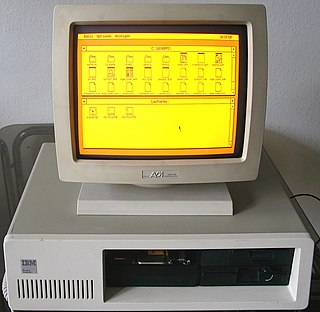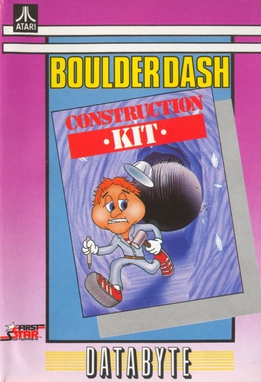Related Research Articles

Atari ST is a line of personal computers from Atari Corporation and the successor to the company's 8-bit home computers. The initial model, the Atari 520ST, had limited release in April–June 1985, and it was widely available in July. The ST was the first personal computer with a bitmapped color graphical user interface, using a version of Digital Research's GEM interface / operating system, from February 1985.

GEM is a discontinued operating environment released by Digital Research in 1985. GEM is known primarily as the native graphical user interface of the Atari ST series of computers, providing a WIMP desktop. It was also available for IBM PC compatibles and shipped with some models from Amstrad. GEM is used as the core for some commercial MS-DOS programs, the most notable being Ventura Publisher. It was ported to other computers that previously lacked graphical interfaces, but never gained traction. The final retail version of GEM was released in 1988.
Microsoft BASIC is the foundation software product of the Microsoft company and evolved into a line of BASIC interpreters and compiler(s) adapted for many different microcomputers. It first appeared in 1975 as Altair BASIC, which was the first version of BASIC published by Microsoft as well as the first high-level programming language available for the Altair 8800 microcomputer.

Macworld is a digital magazine and website dedicated to products and software of Apple Inc., published by Foundry, a subsidiary of IDG.

Silent Service is a submarine simulator video game designed by Sid Meier and published by MicroProse for various 8-bit home computers in 1985 and for 16-bit systems like the Amiga in 1987. A Nintendo Entertainment System version developed by Rare was published in 1989 by Konami in Europe and by Konami's Ultra Games subsidiary in North America. Silent Service II was released in 1990. Tommo purchased the rights to this game and published it online through its Retroism brand in 2015.

Star Wars is a first-person rail shooter designed by Mike Hally and released as an arcade video game in 1983 by Atari, Inc. It uses 3D color vector graphics to simulate the assault on the Death Star from the 1977 film Star Wars. There are three connected gameplay sequences: combat against TIE fighters in space, flying across the surface of the Death Star, and the final trench run. The sequence repeats with added complications and the Death Star regenerating for each. The player's X-Wing fighter has a shield which only protects against damage a certain number of times, then the next hit ends the game. Speech synthesis emulates actors from the film.
General Computer Corporation (GCC), later GCC Technologies, was an American hardware and software company formed in 1981 by Doug Macrae, John Tylko, and Kevin Curran. The company began as a video game developer and created the arcade games Ms. Pac-Man (1982) and Food Fight (1983) as well as designing the hardware for the Atari 7800 console and many of its games. In 1984 the company pivoted to developing home computer peripherals, such as the HyperDrive hard drive for the Macintosh 128K, and printers. GCC was disestablished in 2015.
Optimized Systems Software (OSS) was a company that produced disk operating systems, programming languages with integrated development environments, and applications primarily for Atari 8-bit computers. The founders of OSS previously developed Atari DOS, Atari BASIC, and the Atari Assembler Editor for Atari, Inc., and many OSS products are substantially improved versions. OS A+ and DOS XL are based on Atari DOS. BASIC A+, BASIC XL, and BASIC XE are based on Atari BASIC. EASMD and MAC/65 are modeled on the Atari Assembler Editor. Action! is an ALGOL-inspired compiled programming language with an integrated full-screen editor. OSS also sold some software for the Apple II.

AtariWriter is a word processor program for the Atari 8-bit computers released by Atari, Inc. as a 16 kB ROM cartridge in 1983. The program was fast and easy to use, while still allowing for the creation of fairly complex documents. It was a success for the platform, with at least 800,000 units initially sold, not including international versions and later updates.

Microsoft Write is a basic word processor included with Windows 1.0 and later, until Windows NT 3.51. Throughout its lifespan it was minimally updated, and is comparable to early versions of MacWrite. Early versions of Write only work with Write Document (.wri) files, which are a subset of the Rich Text Format (RTF). After Windows 3.0, Write became capable of reading and composing early Word Document (.doc) files. With Windows 3.1, Write became OLE capable. In Windows 95, Write was replaced with WordPad; attempting to open Write from the Windows folder will open WordPad instead.
Xetec was founded in 1983 by Jon Flickinger, and was located in Salina, Kansas, United States. Before closing in 1995, the company produced many third-party products for the Commodore 64, Commodore 128, Amiga, Macintosh, Atari ST and PC computers.

Many games, utilities, and educational programs were available for Atari 8-bit computers. Atari, Inc. was primarily the publisher following the launch of the Atari 400/800 in 1979, then increasingly by third parties. Atari also distributed "user written" software through the Atari Program Exchange from 1981 to 1984. After APX folded, many titles were picked up by Antic Software.

Shanghai is a computerized version of mahjong solitaire published by Activision in 1986 for the Amiga, Atari ST, Atari 8-bit computers, Commodore 64, MS-DOS, classic Mac OS, Apple IIGS, and Master System. Shanghai was originally programmed by Brodie Lockard. It was released as an arcade video game by Sunsoft in 1988.

The Chessmaster 2000 is a computer chess game by The Software Toolworks. It was the first in the Chessmaster series and published in 1986. It was released for Amiga, Apple II, Atari 8-bit computers, Atari ST, ZX Spectrum, Commodore 64, Amstrad CPC, MSX, Macintosh, and IBM PC compatibles.
Happy drives are series of disk drive enhancements for the Atari 8-bit and Atari ST computer families produced by a small company Happy Computers. Happy Computers is most noted for the add-in boards for the Atari 810 and Atari 1050 floppy disk drives, which achieved a tremendous speed improvement for reading and writing, and for the ability to "back up" floppies. Happy's products were among the most popular Atari computer add-ons. They were still in use and active in the aftermarket as of 2009.

1st Word is a word processor program for the Atari ST developed by GST Computer Systems and published in 1985. It was given away with all ST systems from December 1985 for the next two years. Although it was relatively well received, it was a very simple program, lacking most power features and was very slow when working in large documents. In spite of any limitations, its wide availability made the program's .DOC file format became a de facto standard for the platform and was widely supported by other programs like desktop publishing systems.
Modula-2 is a structured, procedural programming language developed between 1977 and 1985/8 by Niklaus Wirth at ETH Zurich. It was created as the language for the operating system and application software of the Lilith personal workstation. It was later used for programming outside the context of the Lilith.

Boulder Dash Construction Kit is the fourth game in the Boulder Dash series. It was published for the Commodore 64 and Atari 8-bit computers in 1986 by Epyx. Ports were released for the Apple II, Atari ST, Amiga, Amstrad CPC, ZX Spectrum, and MS-DOS. The Spectrum version was rereleased as Boulder Dash IV: The Game. Boulder Dash Construction Kit includes new levels and a level editor.

Blue Max 2001 is a diagonally-scrolling shooter written by Bob Polin for Atari 8-bit computers and published by Synapse Software in 1984. A Commodore 64 version was released the same year. Blue Max 2001 is the sequel to 1983's Blue Max, also by Polin, with the player piloting a futuristic hovercraft instead of a World War I biplane. Critics found the game disappointing compared with the original, citing the indistinct graphics and confusing documentation.
References
- 1 2 3 4 Fleishman, Mike (September 1986). "Megamax C Review". Antic. 5 (5).
- ↑ Mihocka, Darek (November 1988). "Review: Laser C (Megamax, Inc.)". ST-Log (25): 78.
- 1 2 "Megamax C print ad". Atari Mania.
- ↑ "Megaroids". Atari Crypt. February 2, 2016.
- 1 2 Anders, Arick; Bendio, Michael (1986). "Which C for Me?". STart. 1 (2).